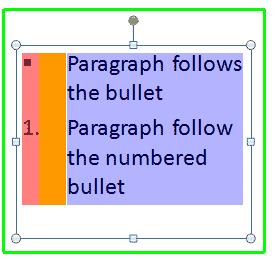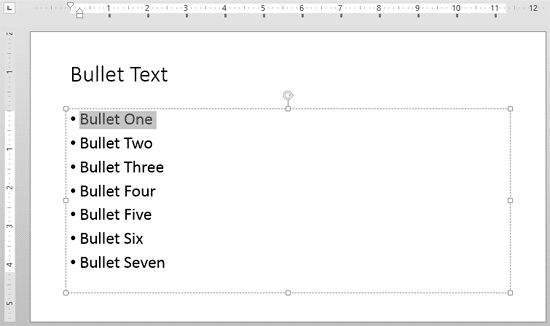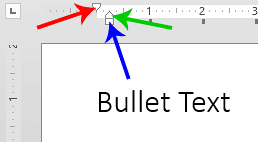Learn about the Indent Markers (Carets) that influence the positioning and spacing of bulleted and numbered lists in PowerPoint 2013 for Windows. There are three such markers or carets in PowerPoint.
Author: Geetesh Bajaj
Product/Version: PowerPoint 2013 for Windows
OS: Microsoft Windows 7 and higher
We have explored how you can apply or change bulleted paragraphs within your text objects. By default, the actual bullet character is always placed before the paragraph that follows it. Also, there is no absolute position of any bullet character you see on your slides. The bullet character's position is always influenced by 4 factors that we explain below, as marked in Figure 1.

Figure 1: Factors that influence the position of bulleted paragraph
Most of the time, the default attributes work very well indeed, and you need not alter any parameters. But if you ever tried changing these parameters to alter the spacing for bulleted paragraphs, you might have discovered that these settings are not too intuitive, and can drive you crazy. In this tutorial, let us start with learning about the different interface parts that influence the position of the bulleted paragraphs.
To make any changes to the bullets, first of all, you have to turn the Rulers on, as shown in Figure 2. Do you notice the rulers above and towards the left of the Slide Area? We will only use the ruler above the slide (also known as the Horizontal Ruler) for the rest of this tutorial.

Figure 2: Rulers made visible
Select some text on your slide, and now look at the Horizontal Ruler. Do you see any Indent Markers, similar to the ones pointed by the red, green, and blue arrows in Figure 3, below? If you don't see any of the Indent Markers on the Horizontal Ruler, make sure that some text has been selected.

Figure 3: Indent markers on horizontal ruler
Look at Figure 3 again, you can see three Indent Markers. For all practical purposes, the terms Carets and Indent Markers denote the same thing. We are using both of them because we want you to know that they are both the same!
The role of these Carets in PowerPoint 2013 is explained below:
The First Line Indent Marker (pointed by the red arrow within Figure 3, above) is also called as the First Indent Marker. This determines the beginning position of the bullet character (or the number in a numbered list). Drag this Caret and your bullet character moves to the new position indicated by this Caret. To learn more about how this Caret works, refer to our First Line Indent Marker in PowerPoint 2013 tutorial.
The Middle Caret (pointed by the green arrow within Figure 3, above) is also known as the Hanging Indent Marker. This adjusts the spacing between the bullet character and the subsequent, following paragraph. We explain this in our Hanging Indent Marker in PowerPoint 2013 tutorial.
The Bottom Caret (pointed by the blue arrow within Figure 3, above) is also called the Left Indent Marker. This Caret essentially links the Top and Middle Carets that we have already explained in the preceding paragraphs. This caret maintains the distance between both the bullet character and the paragraph together as it is moved. Consider this Caret as a lock that retains the distance between the Top and middle Carets. We explain this further in our Left Indent Marker in PowerPoint 2013 tutorial.
Do note that you will see the similar sets of Carets for each individual bullet level.
See Also:
Indent Markers (Carets) for Bulleted and Numbered Lists in PowerPoint 2011 for Mac
Indent Markers (Carets) for Bulleted and Numbered Lists in PowerPoint 2010 for Windows
You May Also Like: crowdbeamer wins Best of Show at InfoComm: Conversation with Peter Ryckaert | Astronomy PowerPoint Templates




Microsoft and the Office logo are trademarks or registered trademarks of Microsoft Corporation in the United States and/or other countries.